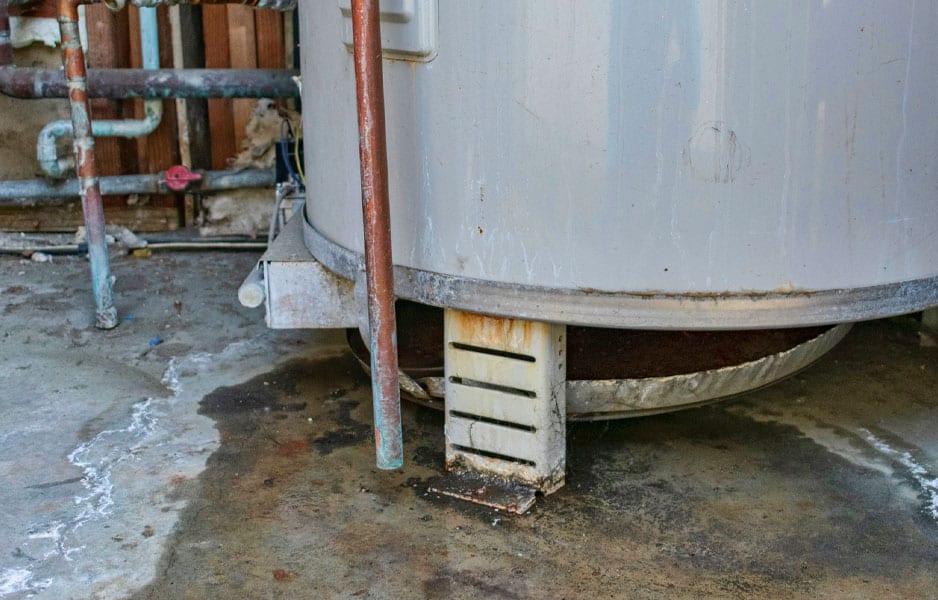A gas water heater pan full of water indicates a possible leak. This issue requires immediate attention to prevent water damage.
Gas water heaters are essential for providing hot water in homes. However, they can develop problems over time. One common issue is water accumulation in the heater pan. This situation can lead to significant water damage if not addressed quickly.
The pan is designed to catch leaks, but a full pan often signals a malfunction. Understanding the causes of this issue is crucial for homeowners. Regular maintenance can help prevent leaks and extend the life of your water heater. Knowing how to respond when you find water in the pan can save you time, money, and stress. Always prioritize safety and seek professional help if needed.

Credit: theoriginalplumber.com
Page Contents
- 1 Introduction To Gas Water Heater Pans
- 2 Immediate Steps When You Discover Water
- 3 Identifying The Source Of Leakage
- 4 Simple Fixes For Minor Issues
- 5 Dealing With A Faulty Temperature And Pressure Relief Valve
- 6 When To Call A Professional
- 7 Preventive Measures To Avoid Future Leaks
- 8 Conclusion: Maintaining A Dry And Safe Environment
- 9 Frequently Asked Questions
- 10 Conclusion
Introduction To Gas Water Heater Pans
A gas water heater pan is important for protecting your home. It collects water that leaks from the heater. This prevents damage to floors and walls. Understanding its purpose helps in maintaining your heater.
The main purpose of a water heater pan is to catch leaks. It directs water away from the heater. This keeps your home safe from water damage. Regular checks are essential to ensure it functions well.
Common reasons for water accumulation include:
- Leaking pipes connected to the heater.
- Corrosion of the water heater.
- Faulty fittings or valves.
- Overheating, which can cause condensation.
Identifying these issues early can save money and prevent damage.

Credit: www.reddit.com
Immediate Steps When You Discover Water
Finding a gas water heater pan full of water can be alarming. First, shut off the gas supply to prevent any hazards. Look for the gas valve near the heater. Turn it clockwise until it stops.
Next, drain the pan to avoid water damage. Locate the drain valve at the bottom. Use a hose to direct water outside or into a bucket. Open the valve carefully to let the water flow out.
Keep an eye on the situation. Check for any leaks in the heater. Call a professional if the problem continues. Taking quick action can save your home from further issues.
Identifying The Source Of Leakage
Start by checking the area around the water heater. Look for visible leaks or puddles. Pay special attention to the pipes and joints. They often show signs of water damage.
Next, inspect the pressure relief valve. This valve releases water if pressure builds up. If it is leaking, water may pool under the heater. Replace a faulty valve to stop leaks.
Use a towel or cloth to dry wet areas. This helps to see new leaks easily. Check regularly to avoid bigger problems later.
Simple Fixes For Minor Issues
Loose connections can cause water to leak. Tightening these connections can solve the problem. Use a wrench to secure nuts and fittings. Check all connections around the heater. A simple twist can make a big difference.
The drain valve may also cause issues. If it leaks, replacing it is easy. First, turn off the water supply. Drain the tank completely before replacement. Use a wrench to remove the old valve. Install a new valve tightly to avoid leaks.
Dealing With A Faulty Temperature And Pressure Relief Valve
Symptoms of a malfunctioning valve include leaks, rust, and water accumulation. You might notice water pooling around the heater. A hissing noise can indicate steam release. Low water pressure is another common sign. If the valve fails, hot water may not flow correctly.
Steps to replace the valve are simple. First, turn off the water heater. Next, drain the tank to avoid spills. Then, remove the old valve by turning it counterclockwise. Install the new valve by twisting it clockwise. Finally, check for leaks after turning the water back on.
When To Call A Professional
Water pooling in the gas water heater pan can mean serious issues. Look for signs like rust, leaks, or an unusual odor. These may indicate that the heater is damaged. Ignoring these signs can lead to more expensive repairs or safety hazards.
Finding a reliable technician is key. Ask for referrals from friends or family. Check online reviews for local technicians. Always verify their credentials and ensure they are licensed. A good technician will offer a clear estimate before starting any work.
Preventive Measures To Avoid Future Leaks
Regular maintenance is key for your gas water heater. Set up a schedule to check for leaks. Inspect the drain pan and drainage regularly. Clear any debris that may block water flow.
Consider upgrading old components. New parts can help prevent future issues. Replace old valves and pipes to avoid leaks. Check the temperature settings on your heater too.
| Maintenance Task | Frequency |
|---|---|
| Inspect Drain Pan | Monthly |
| Check for Leaks | Quarterly |
| Flush Heater | Annually |
| Replace Old Parts | As Needed |

Credit: www.robinsplumbing.com
Conclusion: Maintaining A Dry And Safe Environment
Keeping a dry and safe environment is essential for your home. A water heater pan full of water can cause problems. Here are some quick fixes to consider:
- Check the temperature settings on your heater.
- Inspect for leaks around pipes and connections.
- Ensure the pan drains properly.
- Replace any worn-out parts as needed.
- Monitor the pan regularly for water accumulation.
Ongoing vigilance is key to avoid serious damage. Regular checks can help catch issues early. Maintaining this routine keeps your home safe and dry.
Frequently Asked Questions
Why Is My Hot Water Heater Pan Full Of Water?
A hot water heater pan full of water often indicates a leak. This could stem from a faulty valve, a corroded tank, or condensation. Regular inspections and maintenance can help prevent water buildup. Addressing leaks promptly is essential to avoid further damage.
Why Is There Water At The Bottom Of My Gas Water Heater?
Water at the bottom of your gas water heater often indicates a leak. It may result from condensation, a faulty drain valve, or a corroded tank. Regular maintenance can help identify and fix these issues, preventing further damage and ensuring efficient operation.
Always address water accumulation promptly.
Why Is My Drain Pan Full Of Water?
A full drain pan often indicates a clogged condensate line or a malfunctioning AC unit. Excess moisture can also result from a refrigerant leak. Regular maintenance can prevent these issues. Check for blockages and consider professional help if the problem persists.
What Are Signs That Your Hot Water Heater Is Going Out?
Signs your hot water heater is failing include inconsistent water temperature, strange noises, rusty water, leaks, and a strong odor. If you notice these issues, it’s time to consider repair or replacement. Regular maintenance can help extend your unit’s lifespan and efficiency.
Conclusion
A gas water heater pan filled with water can indicate potential issues. Regular maintenance is crucial to prevent leaks and ensure efficient operation. Always check the pan for standing water. Taking prompt action can save you time and money. Stay proactive to keep your water heater running smoothly and efficiently.
